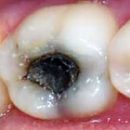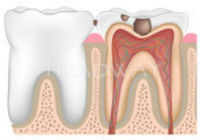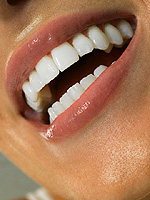What is Pulpitis? What are the causes of pulpita? What is chronic fibrous pulpit? What is chronic gangrenous pulpit? What is chronic hypertrophic pulpit? How the pulpitis is treated? Answers to these questions you will find in the article.
Content
- Pulpitis, reasons for pulpit
- How to treat acute pulpitis
- What is chronic fibrous pulpit
- What is chronic gangrenous pulpit
- What is chronic hypertrophic pulpit
- If you have a pulpit...
Pulpitis, reasons for pulpit
Pulpitis is the inflammation of the soft tissue of the tooth (pulp), which is in the cavity of the tooth, under its solid fabrics, enamel and dentin. Most often, the pulpit is the complication of caries, but there are other reasons for its occurrence.
What can the pulpit occur:
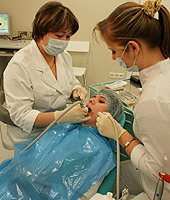 The infection may fall into the pulp from the carious cavity and cause inflammation;
The infection may fall into the pulp from the carious cavity and cause inflammation;
- The infection can get from the gum pocket; The gum pocket is most often formed when the dental deposition between the gums and tooth is deposited, and the infection is accumulated in the resulting deepening and inflammation begins;
- Inflammation of the pulp can begin by the effects of potent chemical stimuli (drugs, sealing materials);
- after mechanical damage to the tooth;
- After overheating the tooth when it is treatment (displacing a crown without a special cooling), which can cause a bullet burn.
Pulpites can arise suddenly and leak acutely in the form of limited inflammation of the pulp (focal pulpit) or with the damage of the entire pulp (diffuse pulpit). But sometimes the inflammatory process occurs slowly and proceeds not very acute, then athighted, then exacerbated. Such pulpits are called chronic. Chronic pulpitis can be fibrous, gangrene and hypertrophic.
Signs of acute pulitic
- arising by themselves (not connected) pain;
- bakery pain with alternating non-barred intervals with pain;
- The emergence of prolonged pains from the impact of various stimuli, which continue after the elimination of these stimuli;
- Strengthening pain at night.
Inflammation begins with a limited plug of pulp, but if the pain hold more than 2 days, then this is a sign that the diffuse inflammation began. Sometimes a sharp inflammatory process goes into chronic and proceeds waves, he is sharpening, then..
How to treat acute pulpitis
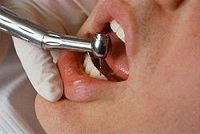 Method of Vital and Devital Amputation. With these methods, a pulp is removed under the crown. Vital amputation is carried out under a special anesthesia, the devotional - after applying the killing pulp (devotative) preparations, for example, arsenic, after which the procedure becomes painless. Then the tooth seal is carried out.
Method of Vital and Devital Amputation. With these methods, a pulp is removed under the crown. Vital amputation is carried out under a special anesthesia, the devotional - after applying the killing pulp (devotative) preparations, for example, arsenic, after which the procedure becomes painless. Then the tooth seal is carried out.
Method of Vital and Devital Extraitation. The techniques are the same, but a complete removal of the entire pulp with the root canal seals is carried out. These methods are used in the preparation of the tooth under the artificial crown.
Biological method. This is a method of complete preservation of the pulp of the tooth, in which the pulp with antibiotics, with special cleaning drugs (enzymes), with the subsequent imposition of dressings with therapeutic dental materials is carried out under anesthesia. After the pulpit after treatment is eliminated, the tooth is seeded.
What is chronic fibrous pulpit
This type of pulpita occurs when the transition of acute inflammation into chronic. At first, an acute pain in the tooth appears, then it subsides and occurs periodically from various stimuli, including inhalation of cold air. But maybe not to be pain. In the area of the tooth, at the same time, a deep carious cavity is most often detected, turning into a cavity of the tooth.
Treatment of chronic fibrous pulpitis is the same as the treatment of acute pulpitis.
What is chronic gangrenous pulpit
If you do not pay attention to a long-term fibrous pulpit, it can go into a gangrene form. At the same time, in the carious cavity, under the influence of a rotary infection, a pulp disintegrates and long-term mischievous pain appear from various stimuli, increasing from hot. Anniversary smell appears, in the area of the tooth, shifts the pulp of a dirty gray.
Treatment of gangrenous pulpitis - Vital (under anesthesia) Extraitation (full removal of pulp).
What is chronic hypertrophic pulpit
This type of pulpitis also develops from chronic fibrosis pulpitis. At the same time, the tissue of pulp and fills the carious cavity, causing severe pain in various influences (chewing, cold, hot, sour, sweet, salty) and bleeding.
Hypertrophic pulpitis is treated with complete removal of pulp (vital and maidistal extirpation).
If you have a pulpit...
- Remove food residues from carious cavity;
- rinse the oral cavity, and it should be remembered that if in the teeth there is no pus, then the rinse with warm water will reduce pain, and if there is a mine, then cold water is suitable;
- introduce a cotto-carious ball with a medicine with medicine with anesthetic effect (analgin, aspirin);
- take an anesthetic medicine inside (analgin, pentalgin, etc.);
- urgently go to the dentist.

